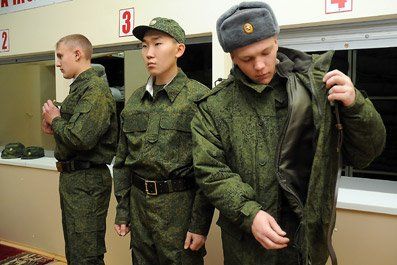
Putin Restores Nationality-Based Units in Russian Military
Publication: Eurasia Daily Monitor Volume: 13 Issue: 163
By:

Three times in the course of the last century, the Russian military has formed ethnically-based units. During World War I, the tsars created the famed “savage” division, which consisted of regiments made up of people from the Caucasus. In the Russian Civil War, such groups arose on both sides as a temporary measure. And during World War II, Soviet leader Joseph Stalin allowed the formation of such units to ease the task of mobilizing the country against the Nazi German invasion.
But in all three cases, senior officials were deeply suspicious of ethnically-based units, fearing they could become seedbeds for secession. So as soon as the crisis these types of units were created to meet passed, the authorities moved to eliminate them. Now, however, as a result of budgetary stringencies, demographic imbalances and the unsettled state of some republics in the Russian Federation, President Vladimir Putin appears to be setting up such institutions once again. Yet, as is so often the case today, this course of action by the Kremlin is being pursued indirectly and deniably by mandating that draftees serve near their homes. The Russian government is thus transforming, in many cases, what should be multi-ethnic and integrative institutions into mono-ethnic and potentially divisive ones.
This process, which the Kremlin has never proclaimed as policy, began more than a decade ago, when the Russian defense ministry said that it would no longer adhere to the Soviet practice of sending draftees far from their home areas; rather it would now allow conscripts to serve nearby. That change was intended to make military service more attractive because it would allow soldiers to more easily maintain ties with their homes and families. It picked up speed in the course of back-and-forth negotiations between Moscow and the leaders of the North Caucasus republics over the last three years as Moscow sought to restart the draft there because of demographic constraints in Russia proper and the non-Russians sought to keep their young men nearby (see EDM, July 10, 2012; November 20, 2014). The result was that Moscow pledged that any draftee from a North Caucasus republic would serve in the region unless he asked to serve elsewhere.
The result of that concession has been the appearance of more military units dominated by non-Russians, something that has forced Moscow to send more Russian-majority units to areas where the security situation has deteriorated. Most analysts both in Moscow and in the West have assumed that this arrangement was specific to the North Caucasus. But in recent weeks, a clear indication emerged that this situation has spread elsewhere and may now be standard operating procedure, even if it has as yet not been acknowledged as official policy.
Tuvinskaya Pravda, the main newspaper of the predominantly Buddhist republic on Russia’s border with Mongolia and one with a long history of anti-Russian activity, reported, on September 28, that “the relocation of the military staff of the 55th motorized rifle brigade and their families to Tuva has begun. The core of this brigade consists of people born in Tuva, and in essence this is the first such military unit since the experience of the Tuvan cavalry squadron, which was staffed by military personnel from the Tuvan People’s Republic and which took part in the liberation of almost 80 cities and villages of Ukraine in 1944.” Tuva was a Soviet satellite state at that time and was absorbed by the Union of Soviet Socialist Republics (USSR) that year (Tuvinskaya Pravda, September 28).
The paper continues with quotations from republic leaders and local people about how proud they are to have their own unit and how they believe that its presence in the republic—it has been moved from just outside now that sufficient housing and other facilities have been built—will serve as a positive advertisement for Tuva and Tuvans. Some of this is simply local boosterism, but that would not be possible if this unit were not composed largely of ethnic Tuvans. And it is likely that other republics and regions of Russia have much the same attitude toward units consisting of local people now based on their territories.
From Moscow’s point of view, such “national units” (even if the center does not openly celebrate them) have three key advantages and three equally important disadvantages. The advantages include significant cost savings, as soldiers do not have to be moved long distances; a better image of the Russian military among local people and hence less resistance to the draft; as well as fewer instances of ethnically-based clashes in the military because ever more units will be dominated either by Russians or by non-Russians.
But there are three major disadvantages: First, this arrangement means that military service will play a far less significant role in promoting the acculturation and assimilation of the non-Russians. Second, it means that integrated groups of non-Russians will train together and acquire military skills that, as the situation in the North Caucasus has shown, they may end up using against Moscow. And third—and this may be the most important consequence of all—non-Russians in particular but many Russians in the regions as well will begin to see these local or national units as a marker of their own sovereignty, distinguishing between them and the all-Russian army.
Whether the advantages or the disadvantages will prove decisive is as yet unclear. But by taking this step in a non-explicit and deniable fashion, Putin is sowing the wind—and he or his successors may well reap the whirlwind as a result.



